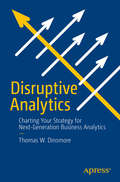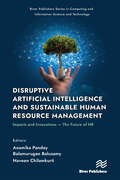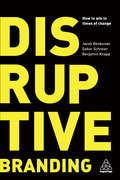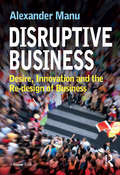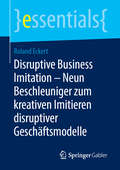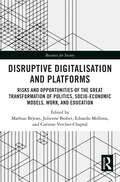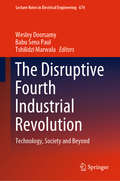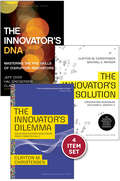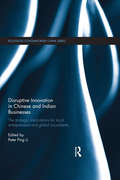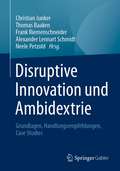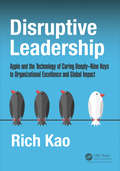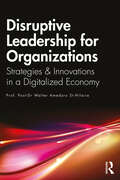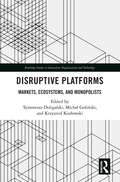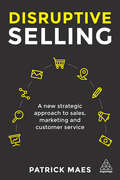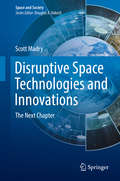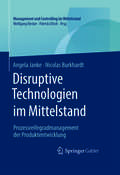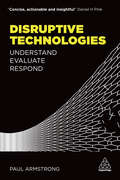- Table View
- List View
Disruptive Analytics
by Thomas W. DinsmoreLearn all you need to know about seven key innovations disrupting business analytics today. These innovations—the open source business model, cloud analytics, the Hadoop ecosystem, Spark and in-memory analytics, streaming analytics, Deep Learning, and self-service analytics—are radically changing how businesses use data for competitive advantage. Taken together, they are disrupting the business analytics value chain, creating new opportunities.Enterprises who seize the opportunity will thrive and prosper, while others struggle and decline: disrupt or be disrupted. Disruptive Business Analytics provides strategies to profit from disruption. It shows you how to organize for insight, build and provision an open source stack, how to practice lean data warehousing, and how to assimilate disruptive innovations into an organization.Through a short history of business analytics and a detailed survey of products and services, analytics authority Thomas W. Dinsmore provides a practical explanation of the most compelling innovations available today.What You'll LearnDiscover how the open source business model works and how to make it work for youSee how cloud computing completely changes the economics of analyticsHarness the power of Hadoop and its ecosystemFind out why Apache Spark is everywhereDiscover the potential of streaming and real-time analyticsLearn what Deep Learning can do and why it mattersSee how self-service analytics can change the way organizations do businessWho This Book Is ForCorporate actors at all levels of responsibility for analytics: analysts, CIOs, CTOs, strategic decision makers, managers, systems architects, technical marketers, product developers, IT personnel, and consultants.
Disruptive Artificial Intelligence and Sustainable Human Resource Management: Impacts and Innovations -The Future of HR (River Publishers Series in Computing and Information Science and Technology)
by Anamika Pandey Balamurugan Balusamy Naveen ChilamkurtiIt is well-established that every organization is founded with a specific purpose and goals. Virtually all business organizations obtain measurements and metrics dealing with outcomes and results. However, what is reflected on the balance sheet does not necessarily show the actual worth of the organizations and ensure their survival and sustainability. Thus, the question arises, what exactly makes the organizations sustainable and thriving in an ever-changing environment? There are several examples of companies like Faber-Castell, Bank of Ireland, Chivas, DuPont and many more which have been able to sustain and survive over more than 200 years and still have a successful existence in the present era. Thus, it is important for the organization to pay equal attention to its three bottom lines, i.e., people, profit and planet for its sustainability, which not only meet the needs of the present generation but should have a futuristic approach as well. In the present era, organizations are adopting a new normal working dynamic and coping with the post-pandemic situations to sustain themselves in the business environment. Technology plays a significant role in this new working dynamic, and cutting-edge technologies like machine learning, artificial intelligence, blockchain,ChatGPT, Internet of Things, and much more effectively facilitate human functioning at work. The book aims to contribute to understanding and developing sustainable human resource management processes and practices aligned with recent technologies. It highlights the interconnection among the three bottom-line sustainable approaches for the growth and development of the organization. Topics discussed in this book include: • Disruptive Technologies and HR Sustainability • Convergence of Innovative Technologies, HR and Organizational Growth • Triple bottom-line Sustainability for HRM • Business-oriented Talent analytics and HR Sustainability • Role of Leadership in sustainable HRM practices.
Disruptive Branding: How to Win in Times of Change
by Jacob Benbunan Gabor Schreier Benjamin KnappDisruptive forces have rewritten the rules of business. In an age of continuous change the strength and authenticity of brands has become more important than ever. The organizations that can master their brand experience are able to survive disruption by disrupting themselves; companies that can't do this will leave themselves ripe for disruption. Disruptive Branding is a practical guide, demonstrating how to harness change to power your brand's survival and ensure growth in a transforming world. It will help ambitious, courageous and aspirational organizations to define their compelling brand strategies, design powerful brand experiences and innovate new brand-led products and services. Disruptive Branding tells the stories of businesses that have succeeded in managing the forces of disruption. From Nintendo fighting off its competition by re-imagining gaming, to Airbnb redefining what it means to travel, modern day brands are thinking faster and smarter than ever before. This book identifies the strategies and designs that some of the world's most successful brands use to stay one step ahead of the curve. It is an invaluable resource for brands working to withstand disruption - or even become disruptors themselves.
Disruptive Business: Desire, Innovation and the Re-design of Business
by Alexander ManuDisruptive Business is a provocative and insightful redefinition of innovation as an outcome of human behaviour, a dynamic in constant change requiring the shaping of new responses in business and the economy. Alexander Manu believes that organizations must treat innovation not as a process to be managed but as an outcome that changes people's lives. In Disruptive Business he explains how innovation is the moment when human behaviour is changed by a particular invention, discovery or event. This position challenges the current understanding of innovation, as well as the current ecology in which innovation operates in organizations: its management, methods, tools, language, focus and metrics. The challenge extends to some of the labels currently applied to innovation typologies, such as 'disruptive innovation', seen today as addressing purely the technological side of an invention, rather than the more complex motivational and behavioural side. Alexander Manu considers that a disruption is not manifest in the moment a new technology is introduced. The disruption is the human being and manifest only when human motivation embraces the technology and uses it to modify and improve everyday life. Our acceptance and appropriation of new technologies creates the business disruption. Manu makes the case that successful innovation outcomes are answers to conscious or subconscious goals residing in human motivation, and motivation starts in desire. This position is consistent with the history of innovations that have changed, improved and reshaped human life, and also consistent with their roots and ethos. Humans are a 'perpetually wanting animal', bound to desire, to seek media for a better self and to need innovation. In this dynamic, innovation is the constant and business is the variable. The role of business is to create the tools, objects and services through which people can manifest what they want and who they are. The book provides a new perspective of current behavioural disruptions which are relevant to the continuity of business, as well as a set of practical methodologies for business design, aimed at creating innovation outcomes of value to users.
Disruptive Business Imitation – Neun Beschleuniger zum kreativen Imitieren disruptiver Geschäftsmodelle
by Roland EckertIm Hyperwettbewerb um Chancenanteile geht es scheinbar nur noch um disruptive Produkt- und Geschäftsmodellinnovationen. Beispiele zeigen jedoch, dass disruptive Imitatoren den disruptiven Innovatoren häufig wirtschaftlich den Rang ablaufen. Entgegen der allgemeinen Meinung scheint auch das kreative Imitieren disruptiver Geschäftsmodelle – das Disruptive Business Imitation Management – im Hyperwettbewerb zunehmend erfolgsrelevant zu werden. Auf diese Managementherausforderung der disruptiven Geschäftsmodellimitation fokussiert das vorliegende essential.Der AutorDr. Roland Eckert ist Professor an der FOM Hochschule für Oekonomie & Management in Essen/Düsseldorf. Er beschäftigt sich seit Jahren mit Fragen des multidimensionalen Innovationsmanagements und der erfolgskritischen Gestaltung intelligenter Echtzeitunternehmen im digitalen Hyperwettbewerb.
Disruptive Digitalisation and Platforms: Risks and Opportunities of the Great Transformation of Politics, Socio-economic Models, Work, and Education (Business for Society)
by Mathias Béjean, Julienne Brabet, Edoardo Mollona, and Corinne Vercher-ChaptalThis book provides an overview of the opportunities and risks of digitalisation and the platforms that embody it and constitute society's new infrastructure. From a management point of view – defined here as the steering of organised and finalised collective action – understanding this major socio-technical disruption is paramount. The book helps to comprehend its main players, such as the American GAFAM, their power and its sources, their architecture, and their impact on different industries and professions, labour markets, companies, and education.Responding to the dominance of tech giants, numerous initiatives are striving to regulate their influence, safeguard democratic sovereignty, promote fair competition in the digital sphere, and employ frugal digitalisation methods to counteract detrimental aspects of these “oligopolistic” platforms. In essence, shouldn't the overarching aim of digitalisation be to foster community development, strengthen individual and collective capabilities, and preserve the environment, while producing goods and services to meet shared societal interests? Throughout the four sections of this book and its 16 chapters, actors in the digital process and/or academics provide analyses and illustrations of the great digital transformation, examining the ways in which socio-technical advances can be created or used for the benefit of all, while avoiding major risks.
Disruptive Diplomas: The Future of Education
by Scott D. Anthony Erik A. Roth Clayton M. ChristensenThis chapter looks at the field of education and posits that the same dynamics that prevail in other industries apply here as well. Signals of change abound, with low-cost/new-market education models springing up. Competitive battles are shaping up between established players and entrants with new capabilities, and incumbents must decide how to respond to disruption.
The Disruptive Fourth Industrial Revolution: Technology, Society and Beyond (Lecture Notes in Electrical Engineering #674)
by Wesley Doorsamy Babu Sena Paul Tshilidzi MarwalaThe book explores technological advances in the fourth industrial revolution (4IR), which is based on a variety of technologies such as artificial intelligence, Internet of Things, machine learning, big data, additive printing, cloud computing, and virtual and augmented reality. Critically analyzing the impacts and effects of these disruptive technologies on various areas, including economics, society, business, government, labor, law, and environment, the book also provides a broad overview of 4IR, with a focus on technologies, to allow readers to gain a deeper understanding of the recent advances and future trajectories. It is intended for researchers, practitioners, policy-makers and industry leaders.
Disruptive Innovation: The Christensen Collection (The Innovator's Dilemma, The Innovator's Solution, The Innovator's DNA, and Harvard Business Review article "How Will You Measure Your Life?")
by Michael E. Raynor Jeff Dyer Clayton M. Christensen Hal GregersenClayton Christensen's definitive works on innovation-offered together for the first timeWill you fall victim to disruptive innovation-or become a disruptor yourself? Tip the odds in your favor with the bestselling books that have made Christensen one of the world's foremost authorities on innovation. You'll also get his award-winning HBR article, full of inspiration for finding meaning and happiness in your life using the principles of business.The 4-volume collection includes:The Innovator's Dilemma: When New Technologies Cause Great Firms to FailIn one of the most influential business books of our time, Christensen introduced the world to the concept of disruptive innovation, showing how even the most outstanding companies can do everything right-yet still lose market leadership. Don't repeat their mistakes.The Innovator's Solution: Creating and Sustaining Successful GrowthCiting in-depth research and theories tested in hundreds of companies across many industries, Christensen and co-author Michael Raynor provide the tools organizations need to become disruptors themselves.The Innovator's DNA: Mastering the Five Skills of Disruptive InnovatorsChristensen and coauthors Jeffrey Dyer and Hal Gregersen identify behaviors of the world's best innovators-from leaders at Amazon and Apple to those at Google, Skype, and the Virgin Group-to show how you and your team can unlock the code to generating and executing more innovative ideas."How Will You Measure Your Life?" (HBR article)At Harvard Business School, Clayton Christensen teaches aspiring MBAs how to apply management and innovation theories to build stronger companies. But he also believes that these models can help people lead better lives. In this award-winning Harvard Business Review article, he explains how, exploring questions everyone needs to ask: How can I be happy in my career? How can I be sure that my relationship with my family is an enduring source of happiness? And how can I live my life with integrity?
Disruptive Innovation in a Digitally Connected Healthy World: 23rd IFIP WG 6.11 Conference on e-Business, e-Services and e-Society, I3E 2024, Heerlen, The Netherlands, September 11–13, 2024, Proceedings (Lecture Notes in Computer Science #14907)
by Rogier van de Wetering Remko Helms Ben Roelens Samaneh Bagheri Yogesh K. Dwivedi Ilias O. Pappas Matti MäntymäkiThis book constitutes the refereed proceedings of the 23rd IFIP WG 6.1 Conference on e-Business, e-Services and e-Society, I3E 2024, held in Heerlen, The Netherlands, during September 11–13, 2024. The 28 full papers and 8 short papers presented in this volume were carefully reviewed and selected from 77 submissions. They were organized in topical sections as follows: Artificial Intelligence Adoption and Impact; Digital Transformation and Organizational Innovation; Healthcare, Social Well-being, and Ethics.
Disruptive Innovation in Chinese and Indian Businesses: The Strategic Implications for Local Entrepreneurs and Global Incumbents (Routledge Contemporary China Series)
by Peter Ping LiWith the rapid development of China and India as new economic powers in global competition, an obvious question is whether these emerging economies are great opportunities or threats. Whilst answers are bound to differ depending on one’s perspective, it is increasingly clear that more local firms, especially local entrepreneurs, from these emerging economies will play a more critical role in global competition by becoming challengers to global incumbents. Indeed, the fact that the majority of their populations are at the bottom of the pyramid, and thus cannot afford products designed for the developed markets, has made these emerging economies fertile ground for developing and applying disruptive innovations. A novel mix of key attributes distinctive from those of established technologies or business models, disruptive innovations are typically inferior, yet affordable and "good-enough" products or services, which originate in lower-end market segments, but later move up to compete with those provided by incumbent firms. This book sheds new light on disruptive innovations both from and for the bottom of the pyramid in China and India, from the point of view of local entrepreneurs and international firms seeking to operate their businesses there. It covers both the theoretical and practical implications of disruptive innovation using conceptual frameworks alongside detailed case studies, whilst also providing a comparison of conditions and strategic options in India and China. Further, unlike existing studies, this book focuses on the neglected perspective of local challengers as the primary players, and in doing so reveals the extent to which the future landscape of global competition may be shaped by disruptive innovation, as well as its capacity to make the world "flatter" and more sustainable. This unique book will be valuable to both scholars and practitioners interested in disruptive innovation and those working in the fields of Asian studies, international business, economics and globalization.
Disruptive Innovation through Digital Transformation: Multi-Sided Platforms of E-Health in China
by Xue Han Yuanyuan Wu Jie ZhengThe book addresses the prevalent digital transformation and focuses on its significant disruption in healthcare. In light of the distinctive characteristics and evolution of the Chinese healthcare industry, private multi-sided platform (MSP) companies emerge to offer novel values and explore the industry value chain. Drawing on the management and economics literature of MSPs, this book examines the selected Chinese MSPs and compares them with the counterpart MSPs in the U.S. This analysis highlights how the unfolding healthcare disruption is valuable for both scholars and practitioners to understand the trends and to take effective actions. “Disruptive Innovation through Digital Transformation: Multi-Sided Platforms of E-Health in China” provides readers in the developing and developed countries with insights on how to approach the current multi-sided platform and to resolve the current problems to better serve customers and patients in the healthcare market.
Disruptive Innovation und Ambidextrie: Grundlagen, Handlungsempfehlungen, Case Studies
by Christian Junker Thomas Baaken Frank Riemenschneider Alexander Lennart Schmidt Neele PetzoldDas Buch bietet neueste Erkenntnisse aus der Forschung der FH Münster zu disruptiven Innovationen und Geschäftsmodellen in Deutschland. Wie entstehen erfolgreiche Innovationen und Geschäftsmodelle, die Märkte radikal verändern und aus einem kleinen Initialfunken sehr schnell wachsen? Und auf der anderen Seite: Wie können sich bereits erfolgreiche Unternehmen im Zuge des disruptiven Wandels gut aufstellen? Wie funktioniert das Zusammenspiel großer, etablierter Unternehmen und junger Start-Ups auf diesem Feld? Diese und weitere Fragen hat die FH Münster in zwei aktuellen Studien untersucht, in denen zahlreiche disruptive und disruptierte Unternehmen untersucht wurden.
Disruptive IPOs? WR Hambrecht & Co.
by Clayton M. Christensen Tara DonovanBill Hambrecht faces a dilemma: should he accept a high profile client for his online Dutch auction IPO? Though it would be viewed as a real coup, what would accepting the business mean to WR Hambrecht? Should he seek other high profile clients like this, or should he try to work with those companies on lower profile financing activities like secondary offerings? Or perhaps he should work with companies that are too small to attract the attention of the big investment banks, who really don't like the whole Dutch auction idea. The case offers a very different setting to apply the theory of disruptive innovation, yet one in an industry that might be quite familiar to many students.
Disruptive IPOs? WR Hambrecht & Co.
by Tara Donovan Clayton M. ChristensenBill Hambrecht faces a dilemma: should he accept a high profile client for his online Dutch auction IPO? Though it would be viewed as a real coup, what would accepting the business mean to WR Hambrecht? Should he seek other high profile clients like this, or should he try to work with those companies on lower profile financing activities like secondary offerings? Or perhaps he should work with companies that are too small to attract the attention of the big investment banks, who really don't like the whole Dutch auction idea. The case offers a very different setting to apply the theory of disruptive innovation, yet one in an industry that might be quite familiar to many students.
Disruptive Leadership: Apple and the Technology of Caring Deeply--Nine Keys to Organizational Excellence and Global Impact
by Rich KaoDisruptive leadership is a topic generating intense interest. Companies all over the world are trying to upend their industry through innovative products and services. Becoming a disruptive organization, however, is easier said than done. Even more difficult is being a company that continually disrupts. Is it possible to discern a code for how companies can achieve this? In this highly readable and engaging book, a disruptive leadership framework is proposed in which caring deeply is placed at the center of the model. By turning care into a focal point, a triphasic model is proposed that moves from the personal sphere (individual), to the corporate arena (organizational), and then to the global stage (impact). Nine keys are identified along this path for how companies can realize organizational excellence. While care may seem like a soft concept in the rough and tumble world of business, it is argued how it is actually an inspired manner for providing direction, structure, and know-how that leads to powerful outcomes. Apple is profiled as a leading example of leveraging what is termed the technology of caring deeply. Other companies, such as Nike, IKEA, Zappos, Starbucks are also profiled. Finally, a leadership canvas is provided to help activate the lessons shared in the book.
Disruptive Leadership for Organizations: Strategies & Innovations in a Digitalized Economy
by Walter Amedzro St-HilaireAimed as much at the neophyte as at the insider who questions why intellectual property rights (IPRs) matter in the digital age and the corporate strategies in the digitalised economy, this book approaches with perspicacity the development of disruptive mechanisms for organisations and IPR-centric leadership. The book is focused on organisations and a management systems perspective. The book identifies the technical practices and proposes multi-level strategies to promote disruptive leadership and encourage growth. The book then addresses the fundamentals of innovation and technology governance, from the production of ideas to the distribution of innovative products or services, including prototyping, financing, industrialisation and so on. It presents recent challenges, including open innovation, creativity and design thinking, and innovation of business models, placing them in the context of knowledge and the collaborative economy. The ambition of the book is to propose a framework for thought and action to the manager, which is composed of five walls – organisational creativity, intellectual property, financing, manufacturing and design of innovation – brought together under one roof, the business model of the technology. This device in which the manager must fit is situated in the strategy of his company and is to be embedded in a specific macroeconomic space.
Disruptive Marketing: What Growth Hackers, Data Punks, and Other Hybrid Thinkers Can Teach Us About Navigating the New Normal
by Geoffrey ColonNow that 75 percent of screen time is spent on connected devices, digital strategies have moved front and center of most marketing plans.But what if that's not enough? What if most people ignore company messages? What if consumer engagement never goes further than the "like" button? A sobering reality is hitting marketers. Technology hasn't just reshaped mass media, it's altering behavior as well. And getting through to customers will take some radical rethinking.First step is to toss the linear plan. Next is to strip away conventions, open your mind, and join Disruptive Marketing on a provocative, fast-paced tour of our changing world . . .Where selling is dead, but ongoing conversation thrivesWhere consumers generate the best content about brandsWhere people tune out noise and listen to feelingsWhere curiosity leads the marketing teamWhere growth depends on merging analytics with boundless creativityPacked with trends, predictions, interviews with big-think marketers, and stories from a career spent pushing boundaries, this book will propel you out of your comfort zone and into the disruptive mindset you need for future success.
Disruptive Platforms: Markets, Ecosystems, and Monopolists (Routledge Studies in Innovation, Organizations and Technology)
by Tymoteusz Doligalski, Michał Goliński, and Krzysztof KozłowskiIt has taken platforms only twenty years to become digital economy hubs. They have changed markets, enterprises, and society. They have expedited communication, collaboration, and trade for consumers, winning their attention and collecting their data. In doing so, they have made processes, products, and industries obsolete, and disrupted the expectations and behaviours of market players. This raises the question, are digital platforms global innovators or disruptive monopolists? Are they a solution to problems of the past or emissaries of a problematic future? This book provides a multi-faceted approach to platforms and their profound impact on markets and ecosystems. Economic, managerial, social, and political aspects are analysed, and the differentiation of platforms and their disruptive potential is reviewed. The book also examines the mechanism of achieving a monopolistic position, including in the international supply chain, and the greater influence of platforms on political activity and contemporary democracy. With examples from Poland, USA, and China, the contributions offer an international evaluation of disruptive platforms across a multitude of industries. The edited collection, prepared by scholars from the SGH Warsaw School of Economics, will be valuable to researchers and academics across the fields of strategic management, marketing, innovations, international business, and the digital economy.
Disruptive Procurement: Winning in a Digital World
by Michael F. Strohmer Stephen Easton Martin Eisenhut Elouise Epstein Robert Kromoser Erik R. Peterson Enrico RizzonDisruptive Procurement is a radical new approach to creating value and innovation by challenging the status quo in the entire product and service line. It requires going far beyond conventional desktop procurement to understand the value the company brings to its customers as well as the value that suppliers bring to the company. By combining knowledge of these two dimensions, companies become far more flexible and they move closer to disrupting the environment in ways that create value. To move toward Disruptive Procurement, companies need a holistic view and a complete new set of capabilities for staff in marketing, sales, R&D, manufacturing, innovation, and, of course, procurement. This will only happen if procurement is fully backed by the Chief Executive Officer and companies embrace digital tools that will help make procurement slimmer and smarter.
Disruptive Selling: A New Strategic Approach to Sales, Marketing and Customer Service
by Patrick MaesThe heyday of the classic sales force is over. Customers lead mobile and online lives, and successful companies use disruptive concepts to engage with the digitally empowered consumer. Disruptive Selling helps companies transform themselves to the new age of selling by matching supply to demand in an innovative way. Successful disruptive selling concepts must be based on the right combination of a series of factors, including an understanding of what motivates customers' corresponding value propositions, appropriate organizational structures, and the right overarching business culture. Disruptive Selling demystifies all of this, and more. Featuring case studies and examples from disruptive organizations such as AirBnB, Zalando and Bol.com, this book will empower readers to look critically at their organizations and commercial interaction models, and begin their own disruptive selling journeys. It contains a carefully researched, clearly explained framework to disruptive selling, and practical guidelines that will allow readers to get started immediately. Regardless of industry, sector or company-size, Disruptive Selling is the ultimate guide to remaining competitive and adaptive in a continually changing world.
Disruptive Space Technologies and Innovations: The Next Chapter (Space and Society)
by Scott MadryIn the past century alone, we have witnessed groundbreaking technological innovations quickly displace established industries, thereby opening up entirely new markets or fields of research. Such "disruptive technologies" are hard to predict in advance, and yet, they have the potential to significantly alter the course of history. Written by one of the world’s leading space applications experts, this book addresses the concept of disruptive technologies in the space arena, including microsatellites, the development of satellite constellations, and reusable launch vehicles.The book presents several case studies in the field, and discusses how and why modern space technologies are so unique. It covers current examples of disruptive space businesses, the pros and cons of such disruption, key emerging trends, and possible developments on the horizon.
Disruptive Technological Change in the Mechanical Excavator Industry
by Clayton M. ChristensenThis chapter explores changes in the mechanical excavator industry, particularly with the advent of hydraulics. Despite the fact that this industry moves at a very different pace and technological intensity than the disk drive industry, the same factors precipitated the failure of both industries to remain competitive in the face of rapid technological change. This chapter was originally published as chapter 3 of "The Innovator's Dilemma: When New Technologies Cause Great Firms to Fail."
Disruptive Technologien im Mittelstand: Prozessreifegradmanagement der Produktentwicklung (Management und Controlling im Mittelstand)
by Angela Janke Nicolas BurkhardtDisruptive Technologien in Produktion und Produkten sind angesichts der Digitalisierung der Dinge (Internet of Things – IoT), Industrie 4.0, des Trends zu erneuerbaren Energien sowie der verstärkten Kundenindividualisierung von zunehmender Bedeutung. Die aktuelle Forschungsliteratur jedoch widmet sich primär dem Erfolg junger Unternehmen und dem Misserfolg etablierter Marktführer im Umfeld disruptiver Technologien. Ziel dieses Buchs ist es, diese Lücke zu schließen und die Möglichkeiten und Grenzen des Prozessreifegradmanagements bei der Entwicklung von Produkten auf Basis disruptiver Technologien zu klären. Es bietet dem Leser ein Reifegradmodell zur Selbstbewertung sowie die Gelegenheit, ein Benchmarking mit dem Best Practice und bewertungsbasierende Handlungsempfehlungen umzusetzen.
Disruptive Technologies: Understand, Evaluate, Respond
by Paul ArmstrongDisruptive Technologies outlines the steps businesses can take to engage with emerging technologies today in order to serve the consumer of tomorrow. This book offers the knowledge and tools to engage confidently with emerging technologies for better business. This highly practical book offers organizations a distinct response to emerging technologies including Blockchain (Bitcoin), artificial intelligence, graphene and nanotechnology (among others) and other external factors (such as the sharing economy, mobile penetration, millennial workforce, ageing populations) that impact on their business, client service and product model.Disruptive Technologies provides a clear roadmap to assess, respond to and problem-solve: what are the upcoming changes in technology, roughly when to respond, and what's the best response? By using a quick-to-master evaluation and decision-making framework - structured around the key dimensions of Technology, Behaviour and Data (TBD). Emerging technologies guru Paul Armstrong offers a clear guide to the key disruptive technologies and a toolbox of frameworks, checklists, and activities to evaluate their possibilities. Disruptive Technologies enables forecasting of potential scenarios, implementation of plans, alternative strategies and the ability to handle change more effectively within an organization. The essential tool for all professionals who need to get to grips with emerging technologies fast and strategically.
